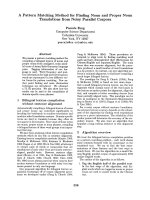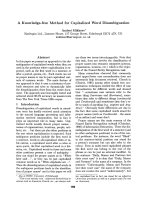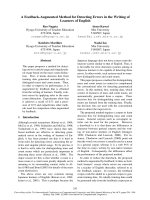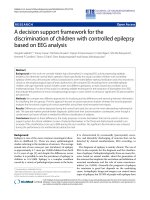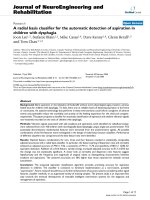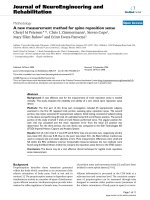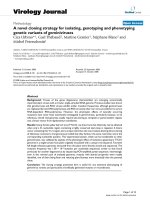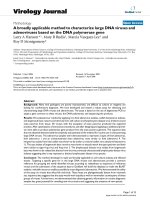Báo cáo hóa học: " A Genetic Programming Method for the Identification of Signal Peptides and Prediction of Their Cleavage Sites David Lennartsson" pot
Bạn đang xem bản rút gọn của tài liệu. Xem và tải ngay bản đầy đủ của tài liệu tại đây (596.58 KB, 8 trang )
EURASIP Journal on Applied Signal Processing 2004:1, 138–145
c
2004 Hindawi Publishing Corporation
A Genetic Programming Method for the Identification
of Signal Peptides and Prediction
of Their Cleavage Sites
David Lennartsson
Saida Medical AB, Stena Center 1A, SE-412 92 G
¨
oteborg, Sweden
Email:
Peter Nordin
Department of Physical Resource Theory, Chalmers University of Technology, SE-412 96 G
¨
oteborg, Sweden
Email:
Received 28 February 2003; Revised 31 July 2003
A novel approach to signal peptide identification is presented. We use an evolutionary algorithm for automatic evolution of
classification programs, so-called programmatic motifs. The variant of evolutionary algorithm used is called genetic programming
where a population of solution candidates in the form of full computer programs is evolved, based on training examples consisting
of signal peptide sequences. The method is compared with a previous work using artificial neural network (ANN) approaches.
Some advantages compared to ANNs are noted. The programmatic motif can perform computational tasks beyond that of feed-
forward neural networks and has also other advantages such as readability. The best motif e volved was analyzed and shown to
detect the h-region of the signal peptide. A p owerful parallel computer cluster was used for the experiment.
Keywords and phrases: signal peptides, genetic programming, bioinformatics, programmatic motif, art ificial neural networks,
cleavage site.
1. INTRODUCTION
The huge and growing amount of unanalyzed data present in
genetic research creates a demand for automatic methods for
classification of proteins and protein properties. Automatic
mechanical means for property screening of interesting pro-
teins would accelerate the process of finding new dr ug candi-
dates.
Classification rules for the processing of amino acid se-
quences can be obtained either by human design or by a me-
chanical process, the latter often through the use of machine-
learning algorithms.
A signal peptide is a short region of amino acid residues
situated at the N-terminal par t of some peptide chains. Com-
monly, signal peptides are referred to as the address tags
within the cell since they control the transport of proteins
through the secretory pathway, the mechanism that moves
proteins through cell membranes. These proteins are pro-
duced by ribosomes in the cytoplasm but the produced pep-
tide does not fold to become a protein at this stage. Instead,
the first part of the peptide, the signal peptide, attaches it-
self to a translocon in the membrane. This binding opens a
channel and the peptide starts to transport itself through the
translocon channel. After transportation through the mem-
brane, the signal peptide cleaves from the protein’s peptide
and the channel is closed. The protein’s peptide is now free
and can fold itself to become an active, or mature, protein.
The existence of a signaling mechanism in the cell was
first postulated by G
¨
unther Blobel in 1971. After a series of
experiments, he came to the correct conclusion that the sig-
nal, or address tag, was coded with amino acids as part of
the peptide and the transport went through channels in the
membranes. Later, Blobel could verify that the process was
universal. The same mechanisms work not only in animal
cells but also in bacteria, yeast, and plants. For his work, Blo-
bel received the Nobel prize in medicine in 1999.
The knowledge about signal peptides has been instru-
mental in understanding some hereditary diseases caused by
proteins not reaching their intended destination. It is also be-
lieved that signal peptides will help in engineer ing yeast cells
into dru g factories. Drugs could then be delivered from the
cells through secretion.
2. PREVIOUS RESEARCH
An early approach to signal peptide classification is the ma-
trix method used by von Heijne in [1]. The matrix was
A GP Method for the Identification of Signal Peptides 139
constructed out of the know n signal peptides at the time and
gave results of a sequence level performance of 78% correct
classification for eukaryotic sequences.
Nielsen et al. [2] improved on the weight matr ix method
and carried out an experiment where they used feed-forward
artificial neural networks trained with backpropagation to
predict if a peptide had a signal peptide attached or not.
To compare this method with the more traditional weight
matrix method, they started with a recalculation of the ma-
trix weights using the sequences already known. In 1996, the
number of known signal peptides was 5–10 times greater
than in 1986. However, the results were considerably worse
than the results obtained by von Heijne in 1986, and only
66% of the eukaryotic sequences were classified successfully.
Nielsen et al. attributes the failure either to larger variation
in the signal peptides found since 1986 or to more frequent
errors in the dataset. The 1986 dataset was hand-compiled
while Nielsen et al. used an automatic method.
The neural network method combined the results of two
individually trained networks that were trained on different
tasks. The first network tried to predict if a specific position
in the sequence was part of the signal peptide or not while the
second network tried to predict if the position was the cleav-
age site. The combined output from the two networks was
based on changes in the output from the first network close
to peaks in the output from the second network. Together,
the two networks managed to predict 70% of the eukaryotic
sequences correctly and 68% of the sequences from the hu-
man dataset. Their method and signal peptide identification
service is known as signalP.
The use of genetic programming (GP) for protein clas-
sification tasks has been pioneered by Koza. In [3], he uses
it to find protein motifs andin[4] he coined the term pro-
grammatic motif and used the method for evolving a rule
that predicted the cellular location of a given protein. Both
experiments produced results better than any other method
at the time, including hand-crafted motifs.
3. DATA
In our experiments, we used the data Nielsen et al. made pub-
lic on their ftp-server [5]. It is the same data they used in
their own experiments and the data originates from SWISS-
PROTversion29[6]. Nielsen et al. started with select ing
sequences marked with SIGNAL. From the SIGNAL group,
they removed all proteins where they could suspect that they
had been tagged as SIGNAL in a nonverified way, that is,
by the use of prediction algorithms or guessing. As a back-
ground, they chose different known cytoplasmic and nuclear
proteins. Here they also removed all entries that seemed to
be nonverified.
Furthermore, they also compared the data and excluded
sequences that were too similar to others. In this way redun-
dancy in the dataset was reduced. For a more detailed de-
scription of the extraction and preparation of the dataset, see
[2, 7].
Nielsen et al. performed their experiment on several dif-
ferent groups of proteins including human, E. coli, eukary-
otes, and gram+ and gram− bacteria, with similar results for
all groups. For experiments described in this paper, we chose
to work only with the human dataset.
In our experiments, the data was split into two sets: one
training set consisting of 176 background proteins and 291
signal peptides and one validation set consisting of 75 back-
ground proteins and 125 signal peptides. For every position
in the peptide sequence, the dataset included information
telling whether it was part of a mature protein or part of
a signal peptide. An excerpt from the dataset is shown in
Figure 1.
The peptide sequences were truncated after 70 amino
acids for background proteins. In the case of signal peptides,
the signal part and the first 30 positions of the mature protein
were kept. This makes sense since the process of translocation
starts before the whole peptide is produced by the ribosome.
4. METHOD
We have used the machine-learning technique GP. GP is
a branch of evolutionary algorithms where computer pro-
grams are evolved from first principles to solve a problem
specified by a fitness function. Although GP has many fea-
turesincommonwithotherbranchesofevolutionarycom-
putation, such as genetic algorithms (where often fixed-
length binary genomes are evolved), the solutions evolved by
a GP system are more complex and can solve harder prob-
lems; they are often complete programs or algorithms.
In GP, a population of solution candidates, individual
programs, is kept and these individuals compete for the right
to reproduce. During mating, variations are introduced in
the offspring’s genome by the use of genetic operators.Two
common simulated operators are mutation and sexual re-
combination. The undirected mechanisms of random vari-
ation combined with selection through survival of the fittest
leads to evolution. The competing individuals in the popula-
tion will usually improve over time at the task by which they
are graded, and the more fit individuals survive and prolifer-
ate.
The solution c andidates, or the individuals, have two ap-
pearances, the genotype and the phenotype. The genotype is
the genome, the recipe that builds the phenotype, and the
behavior of the program. In GP, the phenotype is a program
being executed on a real or simulated machine. Depending on
the phenotype’s performance, the genotype may reproduce.
Since the selection criterion is defined as an external prop-
erty, the algorithm might be seen as more similar to breeding
than to actual evolution.
Three different types of genomes are common in GP:
tree-like, linear, and gr aph-like. In this experiment, a lin-
ear representation of the genome was used. For more back-
ground on GP and discussions about genome, representa-
tion, theory, and different selection mechanisms, see [8, 9,
10, 11].
The individuals in the population had variable-length
genomes that could contain up to 300 instructions. Evolution
started w i th a population with genomes of random length
and random content (genes).
140 EURASIP Journal on Applied Signal Processing
0
70 RPB2_HUMAN DNA-DIRECTED RNA POLYMERASE II 140 KD POLYPEPTIDE
MYDADEDMQYDEDDDEITPDLWQEACWIVISSYFDEKGLVRQQLDSFDEFIQMSVQRIVEDAPPIDLQAE
MMMMMMMMMMMMMMMMMMMMMMMMMMMMMMMMMMMMMMMMMMMMMMMMMMMMMMMMMMMMMMMMMMMMMM
1
51 10KS_HUMAN 21 CLARA CELLS 10 KD SECRETORY PROTEIN PRECURSOR (CC10).
MKLAVTLTLVTLALCCSSASAEICPSFQRVIETLLMDTPSSYEAAMELFSP
SSSSSSSSSSSSSSSSSSSSSCMMMMMMMMMMMMMMMMMMMMMMMMMMMMM
Figure 1: All the sequences have a class, a name, and a specification of which kind of peptide the acid is part of. Here, S means that the
amino acid is part of the signal peptide while C and M are parts of the mature protein; C marks the cleavage site.
PC
Program Registers
The virtual machine
Sequential memory / output
ELF PNAKGENQSP
Peptide sequence
Active
Figure 2: The evolved program instructs the virtual machine to
move along the sequence and to perform calculations on registers
and writing to memory.
4.1. The virtual machine
The linear genomes of the individuals are interpreted as a
computer program by a virtual machine. The virtual machine
used was implemented as a register machine. The machine
had the ability to analyze the peptide sequence, perform
arithmetics with five registers, and use a sequential memory.
A schematic of the machine is shown in Figure 2.
Each position in the individual’s genome represents a
complete inst ruction and is encoded as a 32-bit integer. The
first eight bits encodes the operation while the following
three bytes a re passed as arguments. The most common ar-
gument is a pointer to a register, but depending on the op-
eration, it could also be interpreted as a real-valued constant
or a relative program address. Regardless of how a gene is
coded, it is always reinterpreted as a valid instruction with
valid arguments.
The following operations were supported by the ma-
chine:
(i) Boolean operators: and, or, xor, not;
(ii) register setting operators: one, clear, set;
(iii) arithmetic operators: add, sub, mul, div, sigmoid;
(iv) branching operators: ifgtz, jmp, jmpgtz;
(v) head-moving operators: for, rev, home;
(vi) memory-altering operators: read, write;
(vii) amino acid residue detecting operators: ala, arg, asn,
asp, cys, glu, gln, gly, his, ile, leu, lys, met, phe, pro,
ser, thr, trp, tyr, val, aliphatic, aromatic, charged, hy-
drophobic, negative, polar, positive, small, tiny.
The application-specific operators in this virtual ma-
chine are the amino acid residue detecting operators. These
instructions return positive if the machine is positioned over
the respective target. Otherwise, a negative result is returned.
There are also instructions to determine if a target has a spe-
cific chemical property.
The genome of an individual contains up to 300 instruc-
tions forming a program. The program is the individual and
from this point that is what we refer to when using the word
program. The virtual machine and the computational meth-
ods around it, such as fitness measurement, are referred to a s
the system.
The evaluation of an individual program was executed
once for every peptide in the tr aining set of fitness cases. Be-
fore every run, both registers and sequential memory were
being reset to zero and the program counter was initiated to
zero. The head of the virtual machine was moved to the first
position in the sequence of the peptide to examine.
When the program was executed, it could instruct the
virtual machine to move along the peptide chain and check
for amino acid residues or properties of the residues. In be-
tween those operations, it could perform calculations on its
registers and/or write to sequential memory. The sequen-
tial memory would also be treated as the output of the pro-
gram. If a memory cell in the sequential memory held a value
greater than zero at program termination, that cell’s position
was considered to be a prediction of a cleavage site. The value
zero or less was considered as no prediction.
Programs terminated when reaching the end of the pro-
gram or when a jump instruction instructed the machine
to jump outside the program. If a program used all of its
allowed executions, all branching operators were treated as
NOPs (no operation) and the program terminated when the
end of the program was reached. The execution limit was set
to 800 instructions per run. The program would also termi-
nate if the head was moved outside the peptide sequence.
A GP Method for the Identification of Signal Peptides 141
For a more thorough description of register machine GP,
see [8].
4.2. Fitness measurement
After the evaluation of the peptide sequences, the result had
to be analyzed in order to assign a fitness to the individual.
This process may be the most important in GP due to the
principle “what you train is what you get.”
The main part of the fitness was made up of errors asso-
ciated with the distance between the real and the predicted
cleavage site. For every predicted position, the error d
2
was
added to the fitness. If the program tagged several positions,
it would receive multiple penalties and thus such behavior
would result in poor fitness. If no position was tagged on a
signal peptide, the program would get a penalty that corre-
sponds to a distance d of 17. The same was true for nonsignal
peptides that were falsely classified to have a cleavage site.
To further guide the evolution, the fitness assigning func-
tion was made more smooth by adding a small error for every
position in the memory. The system expected the program to
return one for cleavage sites and minus one for every other
position. Deviations from these values and an extra penalty
p = 0.15 for falsely classified positions were added to the fit-
ness.
Later when the system activated parsimony pressure,it
also added a small cost associated with execution of instruc-
tions to the fitness. This cost was small enough not to affect
the results of the comparison other than when the system
had to choose between two equally performing individuals
with different sizes. Finally, there were some penalties needed
to avoid cheating and control the behavior of the program.
These penalties were large. First, if a program used recursion
and did not terminate before using its available 800 instruc-
tions, it would be punished for loop violation. Second, if a
program produced constant output for different peptides in
the set, the program would get punished.
The last punishment was received if the program tried
to move the head of the virtual machine outside the pep-
tide sequence. This was needed to avoid cheating where the
program otherwise could locate the end of the sequence and
count a certain number of steps back from that point. Such
“cheating” solutions were often evolved by the system if no
penalty was given. The total fitness function is
f =
1
peptides
Peptides
d
2
+parsimony
+
1
length
Positions
e
2
+ p
+loop violation + constant output
+illegal move.
(1)
The fitness was balanced in such a way that individuals
first prioritize minimizing d, then e, and lastly the size of so-
lution (parsimony pressure). The penalties for illegal behav-
ior dominate over all of the above.
a
b
a
b
2nd
1st
2pt crossover
+
2nd
1st
+
Figure 3: If sexual recombination takes place, the children (a
)and
(b
) will be a combination of the parents (a) and (b) genomes. Re-
combination works by letting the crossover operator exchange two
random parts of the genomes.
4.3. Selection and genetic op e rators
We used steady-state tournament selection. For every evo-
lutionary step, four arbitrary individuals are selected. They
compete against each other in two pairs and the best two in-
dividuals from the two (semifinal) games mate.
Mating produces two offspring. It can be either two per-
fect copies of the parents or recombinations of the parents
genomes. Two-point crossover was used for recombination,
shown in Figure 3. There is also a small chance that the
genome of a child will be mutated at a single position.
The two less-performing individuals who were defeated
in the tournament are removed while the parents and the off-
spring stay in the population. The process of tournaments is
iterated over many generations.
4.4. Parallelization
To speed execution up, six workstations were clustered to-
gether using demes. Equal-sized subpopulations were kept
in each deme and one percent of the population migrated to
another deme every generation. The demes were connected
with a ring-like topology.
The clustering gave a full linear speedup and there was
no performance degradation due to clustering. Indications
of superlinear speedups [10] were found but the experiment
did not run su fficient number of times to statistical ly sup-
port such claims. A comparison of the evolutionary progress
for a single population and a population spread over demes
canbeseeninFigure 4. When the system utilizes demes, the
population evolves faster. It can be noted that the effort in
Figure 4 is measured in computer time and that the system
taking advantage of clustering was more than six times faster
in real time than the system utilizing a single workstation.
5. RESULTS
The results presented in the following sections show the
best performing individual. During the run, a population of
twenty thousand programs was evolved for four million tour-
naments. Approximately eight million different solutions
were tried. Parsimony pressure was added after two million
142 EURASIP Journal on Applied Signal Processing
Without demes
With demes
Effort
0 20 40 60 80 100 120 140 160 180 200
2
2.5
3
3.5
4
4.5
Fitness f
Figure 4: A comparison between a demes population and a non-
demes population. The progress of evolution as the function of total
computational effort. The mean fitness out of three runs plotted for
both having the population spread out over demes or keeping all
individuals in a single population.
Best individual (training)
Best individual (validation)
Tournament t
×10
6
00.511.522.533.54
0.5
1
1.5
2
2.5
3
3.5
4
4.5
Fitness f
Figure 5: Fitness for population. The fitness of the two best per-
forming individuals on training and validation data.
tournaments. During mating, there were a 98% probability
of sexual recombination and 15% probability of mutation.
The best performing individual was 273 instructions long
and had formed through 383 genetic operations. The whole
run took about three days on standard PC hardware running
at 500 MHz.
In Figure 5, we can see how the population becomes
more fit over generations. Even though the best individual
continues to improve on training, we do not see evidence of
Table 1: Performance for the identification of signal peptides (best
individual).
Training set Validation set Whole set
Correctly identified (%) 92.5 92.5 92.5
MCC 0.84 0.84 0.84
any overlearning. The individuals are general solutions to the
problem, and fitn ess on validation data remains similar to
that of the training fit ness.
5.1. Identification of signal peptides
The first quality measurement of the individual is how reli-
able the program is classifying a sequence as a signal peptide
or not. Any sequence that produces an output above zero in
any cell of the sequential memory is considered to be a signal
peptide, while the sequences where all outputs are at or below
zero are considered to be classified as background data.
We use the Matthew correlation coefficient [12]todeter-
mine the performance of a rule in addition to percentage of
correctly classified signal peptides. The coefficient is defined
as
C
MCC
=
N
tp
N
tn
− N
fp
N
fn
N
tn
+N
fn
N
tn
+N
fp
N
tp
+N
fn
N
tp
+N
fp
.
(2)
The coefficient C
MCC
equals one for a perfect prediction,
minus one for a total opposite prediction, and zero for a
completely random prediction. The variables N
tp
,N
tn
,N
fp
,
and N
fn
represent the number of correctly classified positives,
correctly classified negatives, falsely classified positives, and
falsely classified negatives, respectively.
The performance of the best individual on the task of
identifying signal peptides is presented in Table 1 . The indi-
vidual managed equally well on the training and validation
cases and actually had a lower fitness on the validation data
than on the training set which indicates that there was no
overtraining.
5.2. Predicting cleavage site location
After identifying which sequences that include a signal pep-
tide, we would like to know w here their cleavage sites are lo-
cated. The individuals are trained to minimize the distance
between predicted and actual cleavage site. This is introduced
in the fitness as a sum over d
2
.
To verify how well the individuals perform on locating
the cleavage site, the percentage of signal peptide sequences
with correctly predicted cleavage sites was measured. In this
case, a correct prediction is a predicted cleavage site at most
two positions away from the real site.
The results of the same best individual as in the previ-
ous sections are presented in Table 2. To further know if this
result was better than a random guess, the average distance
between the predicted cleavage site and the real cleavage site
was calculated.
A GP Method for the Identification of Signal Peptides 143
Table 2: Performance for the prediction of cleavage sites (best indi-
vidual).
Training set Validation set Whole set
Correctly predicted (%) 53.3 61.6 55.8
Mean d
2
12.2 12.7 12.3
To put the measured distance d
2
into perspective, a cou-
ple of different test measurements were carried out. First we
measured how large the mean value of d
2
would be if the
prediction algorithm chose random points distributed uni-
formly between the two extreme positions for cleavage sites
found in the whole dataset. The mean, out of a 100 test runs,
yielded a d
2
of 194. This large d
2
is expected since the distri-
bution of cleavage site positions is far from uniform. Next
step was to use the discrete frequency distribution in the
dataset to transform the randomness to follow the distribu-
tion. These runs gave a mean square distance of 55. Thus, no
random solutions could compete with the measured distance
of the best individual.
Earlier in the studies, the system had produced individu-
als with constant output which managed to reach quite low
fitness and therefore the mean distance for various constant
solutions is needed to be measured. The best constant solu-
tion was the one stating that the cleavage site was positioned
at position 24 in the peptide sequence. This solution had a
mean d
2
of 28.
In comparison with the tests above, it is clear that the best
individual evolved far from being a random guess or optimal
constant solution.
5.3. Analysis of the best individual program
One of the often stated advantages of GP compared, for in-
stance, to ar tificial neural networks is the ability to produce
the result in a human readable form. It is much harder to
analyze the weights and get a grip of how an artificial neu-
ral network is calculating its results than to analyze program
code.
In our case, the task of analysis takes some effort since
we let the program evolve without any constraints on its
architecture. The individuals could evolve loops and sub-
functions with the help of branching instructions. Since the
individuals only had one single linear genome, these func-
tions sometimes overlapped. A loop may partially overlap
with another loop and some parts of the code will be used
differently at different times. Still the function of an individ-
ual is not that hard to understand.
Although the mechanism for targeting signal peptides
work similar in all organisms, the signal peptides do not
share one common sequence. They do however share a com-
mon structure. There are some simple r ules of thumb to de-
tect a signal peptide. First the sequence should start with a
short region, u sually of positively charged amino acids, called
the n-region at the N-terminal of the peptide. It is followed
by a somewhat longer region of hydrophobic amino acids
called the h-region. Between the hydrophobic region and the
cleavage site is a short region consisting mainly of polar and
uncharged amino acids named the c-region. At the positions
before the cleavage site, a pattern called the (
−3, −1) rule
is common. It states that position −1and−3 relatively to
the cleavage site should be occupied by small and neutral
residues. The amino acid residue at position −2 can however
be an aromatic, charged, or large polar residue.
A quick analysis of the program from the best individ-
ual revealed that at most 30% of the instructions contributed
to the solution. The others are known in genetic program-
ming as introns, genes/instructions that are inactive. Introns
are also common in nature and could among other functions
be a product of e volution’s desire to protect important in-
formation in the genome from mutations. In GP, they con-
sist of operations where the results produced will be over-
written by another operator without being used anywhere in
between.
The evolved program consists mainly of two parts where
the first part is made up of four nested loops. The program
will stay inside these loops and iterate over the peptide se-
quence until it has come across four aliphatic residues and
has not detected any proline or arginine. If encountered,
the program will go back and loop some more. When this
happens, the program moves around eleven positions for-
ward. There, it performs a simple check and marks the po-
sition as a cleavage site if there is no tryptophan there. Try p-
tophan is a large aromatic residue. Aliphatic residues are
also hydrophobic, so it seems that our program has found a
simple rule relying on finding the h-region, moving across
the most common number of positions and marking the
cleavage site if not completely wrong. The code seems very
simple but still the program can discriminate between sig-
nal peptides and other proteins with good accuracy. It has
also successfully predicted cleavage sites as close to the N-
terminal as 17 positions and as far away as 37 positions,
so the r u le spans over signal peptides with quite different
characteristics.
6. COMPARISON WITH PREVIOUS METHODS
Nielsen et al. presented their results on the task of the identi-
fication of signal peptides with the help of Matthews correla-
tion coefficient and reported it to be C
SP
= 0.96, as the best,
for the human dataset. This is a good value but they tried
several ways of interpreting the output from the network and
also optimized the threshold value used in the interpretation.
When they only used their cleavage site predicting network,
which is more similar to the approach presented in this pa-
per, and used the highest output to determine if a sequence
has a signal peptide or not, they got a C
SP
= 0.71 which is
worse than the C
SP
= 0.84 reached in this experiment.
When it comes to predicting the cleavage site, Nielsen
et al. reported a 68.0% success rate on the human dataset
using the combined output from two different neural net-
works. The weight matrix method with newly calculated
weights scored 66.7%. According to a survey performed by
Emanuelsson et al. [13], Ta r g e t P, the successor to signalP,
144 EURASIP Journal on Applied Signal Processing
correctly predicted 81.1% of the cleavage sites within two po-
sitions from the real site. The best individual in our experi-
ment scored 55.8%.
Although this is comparing apples to oranges, it can be
interesting to note how much parameters are included in
the solutions. The two networks used to classify human sig-
nal peptides contained in total 3080 real-valued parameters
while the program produced through GP had a length of 273
32-bit instructions. About 30% of these instructions were ac-
tually used in the solution. The instruction set is highly re-
dundant and could easily fit into a 16-bit representation. The
evolved program can be described using much less informa-
tion than the neural network.
GP is also generally less sensitive to initial parameter set-
tings than neural networks, making it possibly a more robust
search tool.
Another difference between the systems is the ability to
learn from the solution derived from the method. The re-
sulting program from the GP system is available in a human-
readable form, although it may take some work to sort it out.
This way, the GP approach holds promise for the future since
it is not only a program that predicts, but also it can produce
new human knowledge.
7. DISCUSSION
The evolved programs have a quite complex architecture with
the ability to create iterations and conditional loops. The
programs evolved by GP can therefore express completely
different patterns than practically possible with ar tificial neu-
ral networks. This may also make a hybrid method between
neural networks and a candidate for future research.
A great deal of effort was spent to prevent programs from
“cheating.” Examples of cheating would be to count positions
from the end of the peptide in the dataset. Although it is clear
that the predictive performance of the neural networks is not
affected by this kind of cheating, it is not fully evident from
publications if enough effort is spent on preventing the net-
work from building up the kind of function needed for all
kinds of possible cheating.
Our results are not verified with cross-validation. In-
stead, we have relied solely on the use of separate training
and validation sets. Since no overlearning has been detected,
we judge this method as sufficient. We would however like to
use cross-validation in the future but there are questions re-
garding its accuracy in combination with evolutionary tech-
niques.
The system identified and extracted a rule similar to a
hand-discovered rule within signal peptide sequence analy-
sis. On the task of the identification of signal peptides, the
evolvedrulefairedwell.Thecombinedscoreoftheneural
networks was however significantly better at prediction of the
cleavage sites.
The interpretability of solutions enables the GP tech-
nique to be used for extraction of new knowledge regarding
cleavage sites and signal peptides. The clear text output en-
ables reformulation as human knowledge.
8. CONCLUSION
We have shown that GP can be used to extract features
in peptide sequences. The resulting “programmatic motifs”
have a high expressiveness and can express other information
than practically possible with, for example, neural networks.
Unlike many other methods, the resulting program is
available in a human-readable form and is interpretable. An
analysis of the program showed that it has evolved a rule that
relied heavily on finding the hydrophobic core in the signal
peptide.
GP is still a young research field and this report describes
one of the first experiments on peptide classification with this
method. Our results points to the feasibility of further use of
genetic programming in sequence analysis tasks.
ACKNOWLEDGMENT
Peter Nordin gratefully acknowledges the support from Owe
Orwar.
REFERENCES
[1] G. von Heijne, “A new method for predicting sig nal sequence
cleavage sites,” Nucleic Acids Res., vol. 14, no. 11, pp. 4683–
4690, 1986.
[2] H. Nielsen, J. Engelbrecht, S. Brunak, and G. von Heijne, “A
neural network method for identification of prokaryotic and
eukaryotic signal peptides and prediction of their cleavage
sites,” Int. J. Neural Syst., vol. 8, no. 5-6, pp. 581–599, 1997.
[3] J. R. Koza and D. Andre, “Automatic discovery of protein mo-
tifs using genetic programming,” in Evolutionary Computa-
tion: Theory and Applications, X. Yao, Ed., World Scientific,
Singapore, 1996.
[4] J. R. Koza, F. Bennett, and D. Andre, “Using programmatic
motifs and genetic programming to classify protein sequences
as to extracellular and membrane cellular location,” in Evolu-
tionary Programming VII: Proceedings of the 7th Annual Con-
ference on Evolutionary Programming,V.W.Porto,N.Sara-
vanan, D. Waagen, and A. E. Eiben, Eds., vol. 1447, Springer-
Verlag, San Diego, Calif, 1998.
[5] H.Nielsen,S.Brunak,J.Engelbrecht,andG.vonHeijne,Data
from signalP ftp-site, />[6] A. Bairoch and B. Boeckmann, “The SWISS-PROT protein
sequence data bank: current status,” Nucleic Acids Res., vol.
22, no. 17, pp. 3578–3580, 1994.
[7] H. Nielsen, J. Engelbrecht, G. von Heijne, and S. Brunak,
“Defining a similarit y threshold for a functional protein se-
quence pattern: the signal peptide cleavage site,” Proteins, vol.
24, pp. 165–177, 1996.
[8] W. Banzhaf, P. Nordin, R. E. Keller, and F. D. Francone, Ge-
netic Programming: An Introduction, Morgan Kaufmann, San
Francisco, Calif, 1998.
[9] J. R. Koza, Genetic Programming: on the Programming of Com-
puters by Means of Natural Selection, MIT Press, Cambridge,
Mass, 1992.
[10] J. R. Koza, F. H. Bennett III, D. Andre, and M. A. Keane, Ge-
netic Programming III: Darwinian Invention and Problem Solv-
ing, Morgan Kaufmann, San Francisco, Calif, 1999.
[11] R. Poli and W. B. Langdon, Foundations of Genetic Program-
ming, Springer-Verlag, Berlin, 2002.
A GP Method for the Identification of Signal Peptides 145
[12] B. W. Matthews, “Comparison of predicted and observed sec-
ondar y structure of T4 phage lysozyme,” Biochemica et Bio-
physica Acta., vol. 405, no. 2, pp. 442–451, 1975.
[13] O. Emanuelsson, H. Nielsen, S. Brunak, and G. von Heijne,
“Predicting subcellular localization of proteins based on their
N-terminal amino acid sequence,” J. Molecular Biology, vol.
300, no. 4, pp. 1005–1016, 2000.
David Lennartsson has been working as
a Consultant in software development for
several years. He received his M.S. degree
in engineering physics from Chalmers Uni-
versity of Technology, Sweden, in 2003.
This paper is or iginally based on his the-
sis work. Currently, he is focusing his re-
search efforts on systems for knowledge ex-
traction and decision support using intel-
ligent heuristics such as genetic program-
ming. M r. Lennartsson is one of the founders of SAIDA Medi-
cal which develops methods for automatic statistical inference and
modelling.
Peter Nordin received his M.S. degree in
computer science and engineering from
Chalmers University of Technology, Swe-
den, in 1989, and his Ph.D. degree in com-
puter science from the University of Dort-
mund, Germany, in 1997. He has worked
for several years as a Researcher and Con-
sultant in the area of knowledge-based sys-
tems, artificial intelligence, and evolution-
ar y algorithms at Infologics AB, a subsidiary
of Swedish telecom. Dr. Nordin is a Cofounder of Dacapo AB, a
Swedish consulting and research company specialised in the state-
of-the-art information technology, and an Inventor of the patented
AIM-GP genetic programming method, a very efficient approach
to GP. He has published 90 papers on genetic programming. He has
been Program Cochair of EuroGP’99, Second European Workshop
on Genetic Programming, and is in the editorial board of the Jour-
nal of Genetic Programming and Evolvable Hardware. Dr. Nordin
has been a member of several European research projects. Since
1998, he has been an Associate Professor in the Complex Systems
Group at Chalmers University of Technology.

